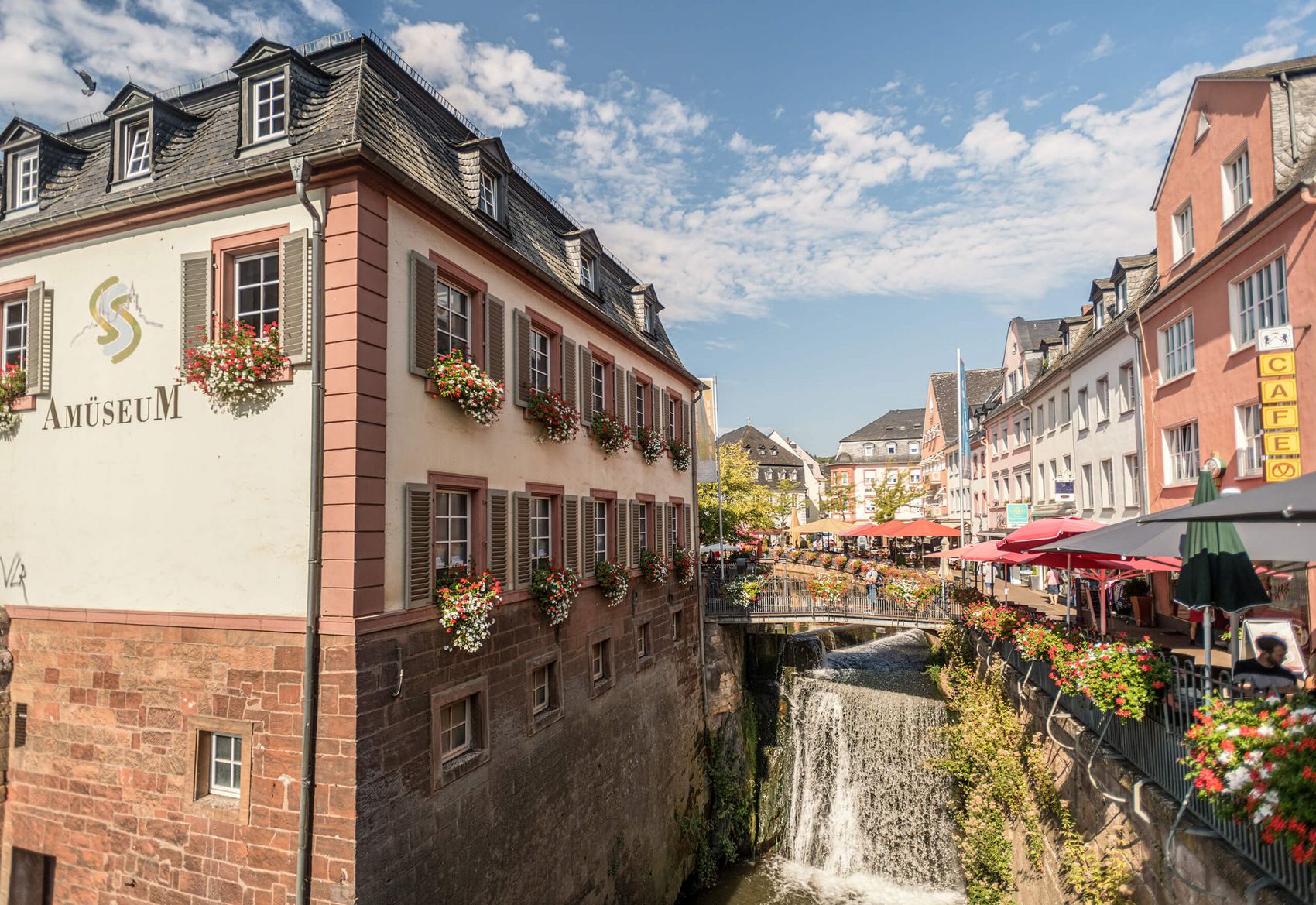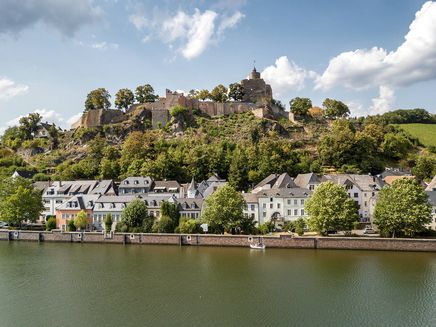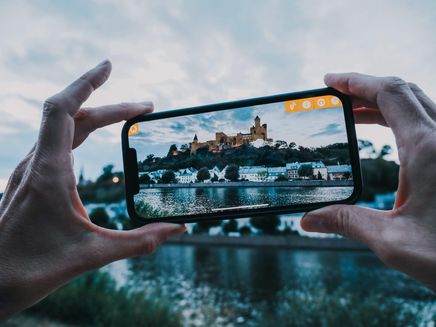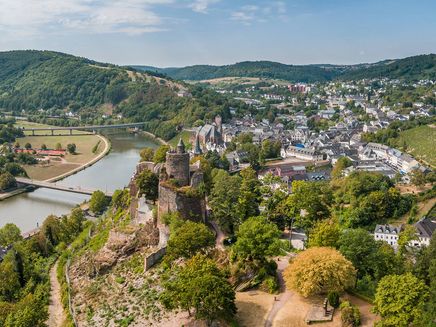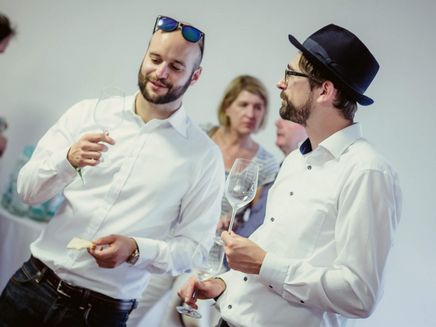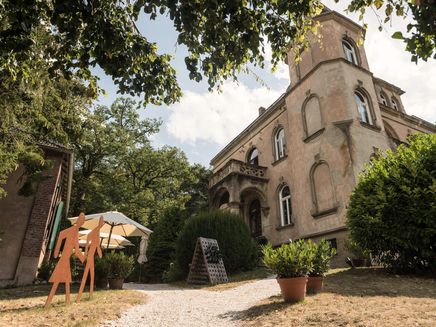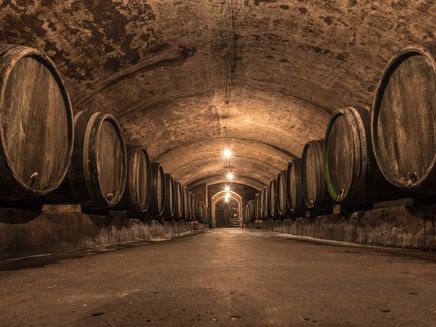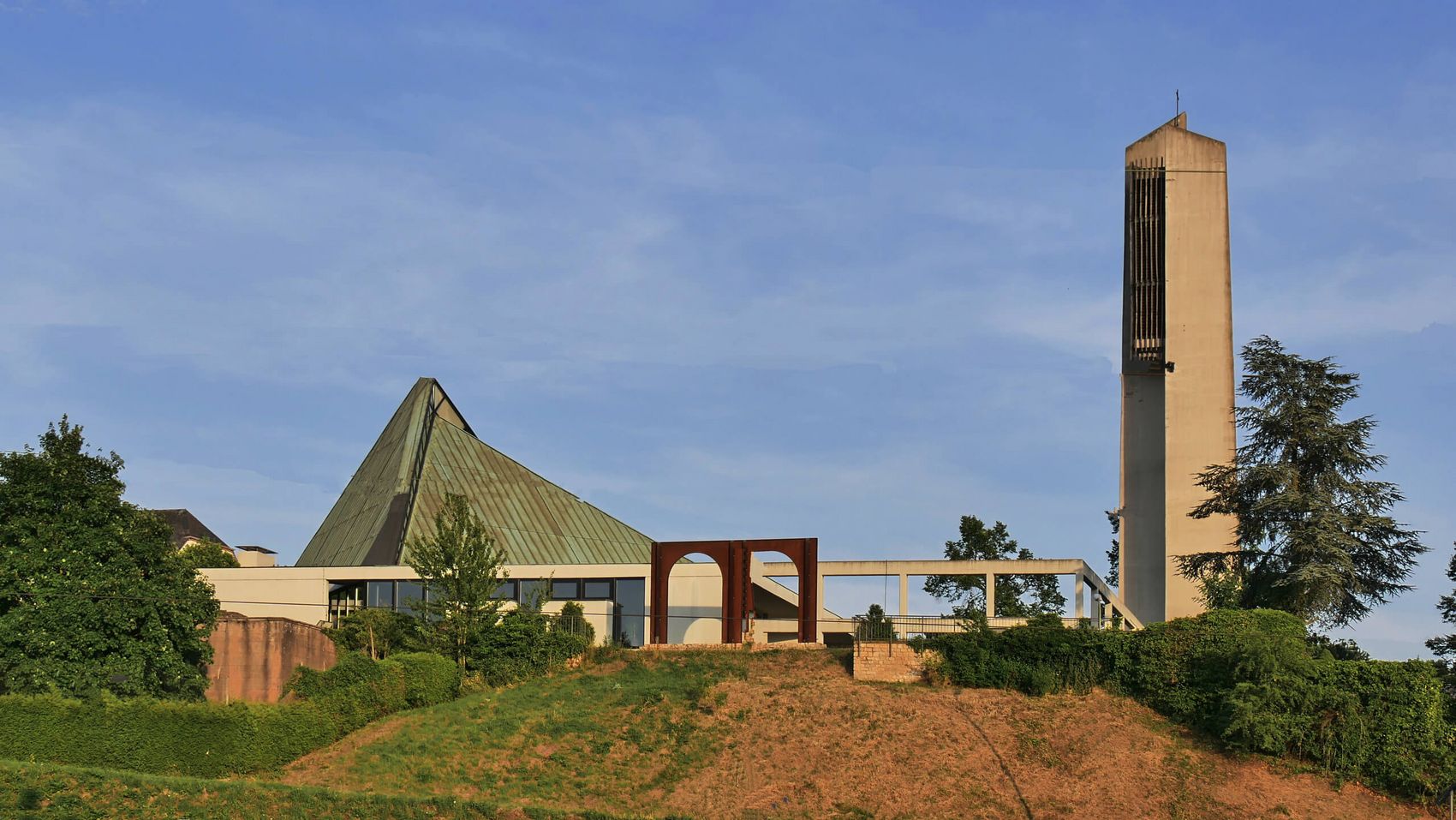Saarburg is quite unusual: a broad stream flows through the centre of the old town and cascades down into the valley in a large waterfall. But this waterfall isn’t the only reason you should spend some time in Saarburg. As the name suggests, the historic town is situated along the Saar River, which meanders right through the heart of a first-class wine-growing region. World-famous Riesling wines grow on the steep slopes here, and the magnificent architecture of the vineyards bears witness to the economic success of the estate owners. The region also has plenty to offer in the way of culture. Some sights can even be seen in their former glory via augmented reality. All you have to do is download the free ARGO apponto your smartphone.
Let’s go sightseeing!
Because of its hillside location, Saarburg is divided into an upper and a lower town. We recommend starting off in the town centre, in upper Saarburg. Follow the wide course of the river Leukbach until you reach the waterfall, which tumbles almost 20 metres in depth! The river was deliberately redirected through the city in the Middle Ages to harness its water power. Plus, this was also a way of having access to water in the case of fires.
There are two mills at the foot of the waterfall: the Hackenberger Mühleand the former Kurfürstliche Mühle, which are now home to a mill museumand theAmüseum. You should definitely make time for a visit!
The oldest part of Saarburg is known as the “Staden”, an old fishing settlement. Trade signage can still be seen outside the entrances of some of the houses there. This part of the city also had a bell foundry, which is now open to the public as a museum.
Saarburg Castle ruins
Overlooking the town are theruins of Saarburg Castle. Built in 964, it is one of western Germany’s oldest hilltop castles and was once the seat of a powerful noble dynasty. Its commissioner, Count Siegfried of Luxembourg, also founded the city of Luxembourg, which formed the foundations of what would become the Grand Duchy. During the 14th century, Saarburg Castle became property of the church and was, for a time, the preferred residence of the archbishops of Trier.
Unfortunately, only ruins remain today, but you can still see the enclosing walls and residential tower. Enjoy the beautiful panoramic views of the Saar Valley! By using the augmented reality feature of the free ARGO app, you can see what the castle looked like before it was destroyed.
Bell foundry
Be sure to visit the KulturGießerei Saarburg at Staden 130!
Dating back to 1770, the family-run foundry produced bells that were sold all over the world for almost three centuries. The museum isinteractive and part of the KulturGießerei sociocultural centre, which also provides a great setting for cultural events.
Pilgrimage Church of St. Mary
The miraculous image of a nursing Madonna has been revered in Saarburg for over 700 years. You can find her in the pilgrimage church, a Gothic hall building with two naves, located in the Beurig district. Take a look at the altar of grace, a sandstone, marble and alabaster work of art by Johannes Manternach, which was donated in 1622. The cross altar is also worth seeing, a beautiful late Renaissance work that is also attributed to Manternach. Most pilgrimages to Beurig take place between May and September. The main pilgrimage day takes place the Sunday after the 2nd of July, the Feast of the Visitation of Mary.
Your Saar wine experience
Saar Riesling wines are among the best wines in the world and are characterised by their elegance and minerality. They are considered to age well and can often still surprise you with their freshness decades later. The Saar Valley is home to a number of exceptional winemakers!
Here are our tips on the best places to taste excellent Saar wines in Saarburg:
Thevinothek Bonsai & Wein, at Kunohof 20, serves wines from the Saar’s most renowned wineries, such as Egon Müller-Scharzhof, Forstmeister Geltz-Zilliken, Dr. Wagner, Stefan Müller, Van Volxem, Peter Lauer and von Othegraven.
At the vinothek belonging to Weingut Dr. Wagner, you can taste wines and sparkling wines directly where they are produced. Built in 1898, complete with turret, sweeping staircase and balcony, the grand manor stands proudly in the middle of park grounds. The wines mature in old oak barrels in the Saar’s largest vaulted cellar. Today, the winery is run by Christiane Wagner, who is the fifth generation of her family to continue the business.
If you plan your trip to the Saar and Upper Mosel for the end of August, you can enjoy theSaarRieslingSommer, a great wine-tasting event in which all the Saar wineries of note take part. German TV presenter Günter Jauch’s Weingut Von Othegraven is also among the participants. Date of the next “SaarRieslingSommer”: 29 - 31 August 2025.
Trip to Kastel-Staadt and the romantic Klause hermitage
An architectural treasure of German Romanticism awaits you just 10 km away from Saarburg: the Klause Kastel hermitage in Kastel-Staadt. Built into the chiselled sandstone cliffs high above the Saar, it offers stunning views over the valley. It was built according to plans by Karl Friedrich Schinkel, a great painter and architect of German Romanticism.
The elevated plateau of Kastel-Staadt is an extremely picturesque place with a fascinating history. It was here that the Celtic Treveri tribe first founded a large settlement similar to a town, which was effectively the precursor of the city of Trier. A huge temple complex was built when the Romans conquered the region, and the remains of its theatre can still be seen today. Take a look at the architecture via augmented reality with the free ARGO app!
From the visitors car park, you will first come to the medieval parish church of St. John the Baptist, which was once part of a village that was abandoned long ago. From there, the route leads to the Kastel hermitage and a large memorial cemetery for those who died in the Second World War. You can enjoy another stunning view of the Saar Valley from the cross of remembrance there.
Freudenburg Castle ruins
Just 4 km on from Kastel-Staadt lie the ruins of another castle, the Freudenburg. It was commissioned by the same King John of Bohemia, who was later buried at the Kastel hermitage. The castle was originally part of a belt of fortifications against the expansionist ambitions of Elector Balduin of Trier. It presides over a rocky outcrop and looks like the prow of a ship from above. A circular heritage trail leads to the castle grounds and the old village centre of the same name. By using the free ARGO app, you can see an augmented reality version of what Freudenburg Castle looked like before its destruction. The premium Moselsteig Seitensprung hiking trail “König-Johann-Runde” combines the historic castle complex with diverse landscapes, endless views, sandstone cliffs and the Eiderberg nature conservation area.
Tawern Temple
A large Roman temple complex has been impressively reconstructed on the Metzenberg in Tawern. The ARGO augmented reality app can be used here as well. Starting out from a hikers car park, you can wander through the forest and feel like you’re right in the middle of the Roman era! Once in the village of Tawern, you will see the remains of a Roman settlement which the temple complex once belonged to. At this point, it becomes clear where the village got its name: from the Latin “taberna”, which means shop, inn or workshop.
Georg Meistermann in Konz
Are you interested in modern religious art and architecture? The Church of St. Nicholas in Konz was built according to the plans of Swiss architect Hermann Baur. His style was inspired by the movements of Neues Bauen (New Building) and Neue Sachlichkeit (New Objectivity), and had a decisive impact on Swiss architecture in the 20th century. Instead of the usual rectangular floor plan, Baur created a dynamic space with his church buildings, so conveying a new, modern, conceptual statement. The architectural structure of the church in Konz reflects the idea that “God’s dwelling place is now among the people”. To complement Baur’s modern architecture, the renowned artist Georg Meistermann was commissioned to create altarpieces for the church and crypt. These are now considered some of the most significant works of modern church art.
Furthermore, the church partly stands on the remains of aRoman imperial palace from late antiquity. Using the augmented reality feature of the free ARGO app, you can superimpose a reconstruction of the ancient ruins.
Stop for a bite to eat in Konz
From the Church of St. Nicholas you can see down to the beautiful historic railway station in Konz, which now houses a recommendable restaurant-café with a beer garden. Fresh regional and seasonal cuisine awaits you there.
The Konz Music Festival
A musical event highlight in the region is the Konz Music Festival, under the artistic direction of pianist Joseph Moog. The festival features chamber music concerts with international artists, which are performed in the historic former Monastery of St. Bruno / “Karthaus” Abbey in Konz as well as at various venues in the surrounding area.
Accommodation and dining in Saarburg
If you are looking for accommodation directly in Saarburg, we recommend the Hotel-Restaurant Villa Keller along the Saar. It offers stylish, sophisticated hotel rooms and wonderful views of the Saar and the castle.
A great place to eat in the old town is the Saarburger Hof where Klaus Diewald heads the kitchen team. Excellent Italian cuisine can be found at Burgrestaurant di Vincenzo Di Tuoro located directly next to Saarburg Castle.
Luxury hotels in the area
Looking for an extra-special place to stay in the Saarburg area?
The Hotel-Restaurant St. Erasmus in Trassem (4 km from Saarburg) is an excellent 4-star option. It offers first-class cuisine, a choice of accommodation with stylish ambience and a spa area to relax in.
The modern WEINhotel & Gästehaus Ayler Kupp in Ayl (approx. 5 km from Saarburg) is passionate about indulgence and art and describes itself as a place to enjoy yourself, drink wine, feel at home and stay a while. The Michelin Guide recommends the excellent WEINrestaurant, as does the Falstaff Restaurant Guide Germany.
Day trip to Trier
What about a trip to Germany’s oldest city? Trier offers a wealth of attractions including eight UNESCO World Heritage Sites and a number of other highlights from the Roman era. Don’t miss out on the charm of this historic city!
